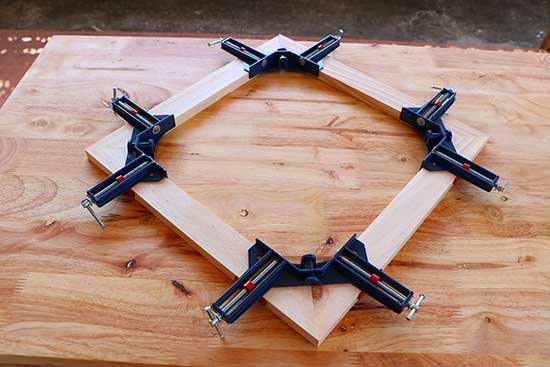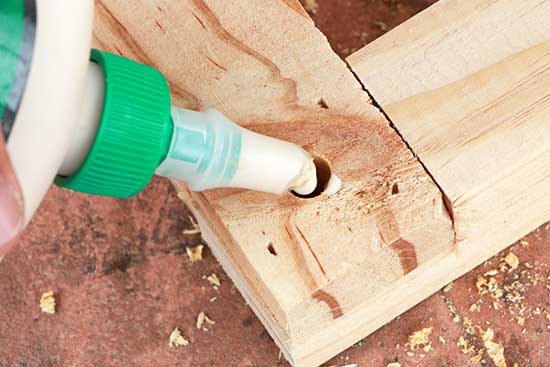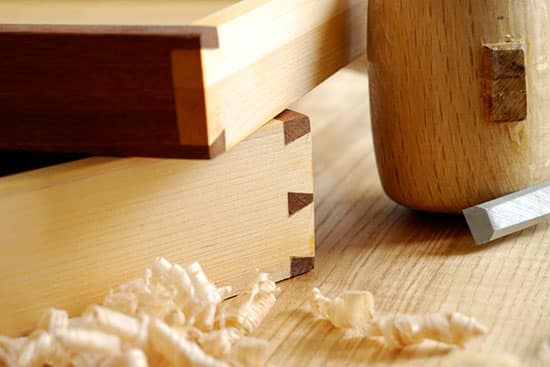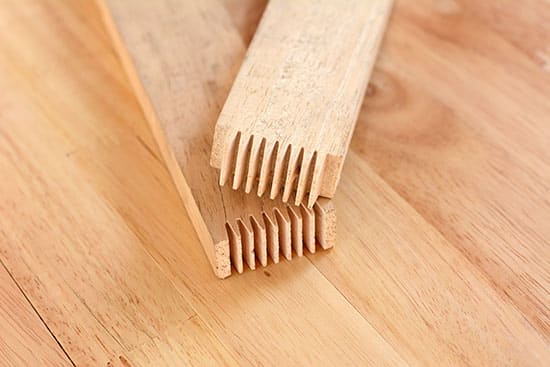The Ultimate Guide to Woodworking Joints
 Trying to decide on the right woodworking joints for your project?
Trying to decide on the right woodworking joints for your project?
Woodworking joints are the foundation for fine craftsmanship. With them, you can create pieces that are both beautiful and functional. And the more advanced of a woodworker you are, the more you’ll want to experiment with all the options.
Here, we’ll give you an overview of all the different types of joints and the techniques you’ll need for making them. You can expect to learn about:
- Woodworking joint anatomy
- Types of joints
- Advanced joints
- Tips for specific projects
- Common issues
- Mistakes to avoid
The Anatomy of Woodworking Joints
A woodworking joint secures two pieces of wood together—whether with adhesives or fasteners.
The strength of that joint depends on the following four factors:
- Wood species: Different wood species have varying densities and strengths, which can impact the overall strength of a joint.
- Grain orientation: Proper grain orientation can maximize the strength of a joint, while improper alignment can weaken it.
- Adhesives and fasteners: Quality glues and fasteners contribute to a joint’s strength and longevity.
- Proper clamping and assembly techniques: Ensuring even pressure and correct alignment during assembly helps create a strong, lasting joint.
Let’s look at the options you have for joints.
Types of Woodworking Joints
Understanding the different types of woodworking joints is essential for woodworkers, as each joint offers unique advantages and characteristics that make them suitable for specific applications.
Butt Joint
This is the simplest joint, in which two pieces of wood are joined end-to-end or end-to-edge.
- Uses: Basic framing and paneling
- Strength and limitations: Weak on its own, but can be reinforced with fasteners, adhesives, or additional joinery techniques
- Tips for improving strength: Use strong adhesives, dowels, or screws to increase the joint’s stability and strength.
Miter Joint
Two pieces of wood are cut at complementary angles, usually 45 degrees, and joined together to form a 90-degree angle.
- Uses: Picture frames and decorative trim
- Strength and limitations: Moderate strength when reinforced with adhesives, but susceptible to separation under stress
- Tips for improving strength: Use splines, biscuits, or dowels to reinforce the joint, along with a strong adhesive.
Lap Joint
A portion of each piece of wood is removed, leaving a flat surface that overlaps with the other piece.
- Uses: Joining the ends of boards, such as in table legs or support braces
- Strength and limitations: Stronger than a butt joint but weaker than a mortise and tenon. Limited to joining pieces of the same thickness
- Tips for improving strength: Ensure a tight fit and use strong adhesives, screws, or dowels for reinforcement.
Dado Joint
A groove (known as a dado) is cut across one piece of wood, and the other piece is fitted into the groove.
- Use: Cabinetry and shelving
- Strength and limitations: Stronger than a butt joint but less versatile than a mortise and tenon. Limited to joining pieces perpendicular to one another
- Tips for improving strength: Use strong adhesives and precise measurements for a snug fit.
Rabbet Joint
A rectangular notch (a rabbet) is cut into the edge of one piece of wood, and the other piece is joined at a right angle.
- Use: Cabinet and frame construction
- Strength and limitations: Moderate strength, but prone to separation under stress. Can be reinforced with adhesives or fasteners.
- Tips for improving strength: Ensure a tight fit, use strong adhesives, and consider reinforcing with screws, dowels, or nails.
Mortise and Tenon Joint
A tenon is a protruding piece of wood that is cut on the end of one piece. It’s designed to fit into a matching mortise (recess) that has been cut into the other piece.
- Use: Furniture and frame construction
- Strength and limitations: Offers excellent strength and versatility, but requires precision and skill to execute properly
- Tips for improving strength: Ensure a tight fit, use strong adhesives, and consider reinforcing with wedges, pins, or drawboring (offsetting the hole for a wooden peg, creating tension, and holding the joint together).
Dowel Joint
 Holes are drilled into both pieces of wood, and wooden dowels—small, cylindrical pieces of wood—are inserted to align and join the pieces.
Holes are drilled into both pieces of wood, and wooden dowels—small, cylindrical pieces of wood—are inserted to align and join the pieces.
- Use: Furniture assembly and cabinetry
- Strength and limitations: Provides good strength but relies on precise hole placement and dowel sizing
- Tips for improving strength: Use quality dowels, strong adhesives, and precise measurements to ensure a secure fit.
Biscuit Joint
Oval-shaped slots are cut into both pieces of wood, and a wooden biscuit—a thin, oval-shaped piece of wood—is inserted to align and join the pieces.
- Use: In edge-to-edge joints, such as in tabletops or paneling
- Strength and limitations: Offers moderate strength, but relies on precise slot placement and biscuit sizing.
- Tips for improving strength: Use quality biscuits, strong adhesives, and precise measurements to ensure a secure fit.
Dovetail Joint
 Interlocking wedge-shaped pins and tails are cut into the ends of two pieces of wood, creating a strong mechanical connection.
Interlocking wedge-shaped pins and tails are cut into the ends of two pieces of wood, creating a strong mechanical connection.
- Use: Drawer and box construction.
- Strength and limitations: Provides excellent strength and resistance to pulling forces, but requires skill and precision to execute properly
- Tips for improving strength: Ensure tight-fitting pins and tails, and use strong adhesives for added durability.
Box Joint
Square interlocking fingers are cut into the ends of two pieces of wood, creating a strong mechanical connection.
- Use: As an alternative to dovetail joints in box construction
- Strength and limitations: Offers good strength and resistance to pulling forces but is less attractive than a dovetail joint
- Tips for improving strength: Ensure a snug fit, use strong adhesives, and consider reinforcing with nails or screws if necessary.
Finger Joint
 Interlocking, comb-like fingers are cut into the ends of two pieces of wood, creating a strong mechanical connection.
Interlocking, comb-like fingers are cut into the ends of two pieces of wood, creating a strong mechanical connection.
- Use: To join long boards for molding, trim, or tabletops
- Strength and limitations: Provides good strength and resistance to pulling forces but is less attractive than a dovetail or box joint
- Tips for improving strength: Ensure a tight fit, use strong adhesives, and consider reinforcing with screws or nails if necessary.
Advanced Woodworking Joints
Bridle Joint
A tenon is formed on the end of one piece of wood, and a matching open-ended mortise (or bridle) is cut into the other piece.
- Use: Connecting rails to posts or legs
- Strength and limitations: Provides good strength but requires precise cutting and fitting
- Tips for improving strength: Ensure a tight fit and use strong adhesives or screws for added reinforcement.
Scarf Joint
Two angled cuts, called a scarf, are made on the ends of two pieces of wood, which are then overlapped and joined together.
- Use: Joining long boards or beams
- Strength and limitations: Provides good strength but relies on accurate cutting and fitting
- Tips for improving strength: Use strong adhesives, and consider reinforcing with dowels, screws, or bolts.
Half-blind and Full-blind Dovetails
These are variations of the dovetail joint in which the tails or pins are partially or fully concealed from view.
- Use: Drawers or boxes where a clean appearance is desired
- Strength and limitations: Offers excellent strength but requires greater skill and precision than standard dovetails
- Tips for improving strength: Use strong adhesives, ensure a tight fit, and practice proper cutting techniques.
Lock Miter Joint
This joint is like a miter joint with interlocking profiles cut into the edges of both pieces.
- Use: Boxes, cabinets, or frames with hidden joints
- Strength and limitations: Provides good strength but requires precise cutting and setup
- Tips for improving strength: Use strong adhesives, ensure a snug fit, and practice proper cutting techniques.
Tapered Sliding Dovetail
This one is a variation of the dovetail joint in which the tails and pins are tapered, allowing the joint to slide together and lock in place.
- Use: Furniture construction for attaching shelves or partitions
- Strength and limitations: Offers excellent strength and resistance to pulling forces but requires advanced skill and precision to execute properly
- Tips for improving strength: Ensure a tight fit, use strong adhesives, and practice proper cutting techniques.
Twin Tenon Joint
A twin tenon joint is a variation of the mortise and tenon joint featuring two tenons on one piece of wood, fitting into two corresponding mortises.
- Use: Pieces requiring added strength, such as chairs or tables
- Strength and limitations: Provides increased strength compared to a single mortise and tenon joint but requires greater precision in cutting and fitting
- Tips for improving strength: Ensure a tight fit, use strong adhesives, and consider reinforcing with wedges, pins, or drawboring.
Locking Rabbet Joint
The locking rabbet joint is a variation of the traditional rabbet joint, in which a stepped groove is cut into the edge of one piece of wood, allowing another piece to interlock securely.
- Use: Cabinetry, shelving, and picture frames, where the joint provides a clean, concealed connection
- Strength and limitations: Offers good strength and resistance to lateral forces, but requires careful planning and precise cutting for accurate fit
- Tips for improving strength: Ensure a tight fit, use strong adhesives, and reinforce with screws or nails if needed.
Birdsmouth Joint
A V-shaped notch is cut into the end of a rafter or beam, allowing it to sit securely on top of a horizontal support. It’s less likely to be used as a woodworking joint, but we included it in our list for you DIYers who are thinking about building a shed or a woodworking shop.
- Use: Roof construction and timber framing
- Strength and limitations: Offers good strength and stability but requires precise cutting and fitting
- Tips for improving strength: Ensure a snug fit and use strong fasteners, such as nails or screws, for added reinforcement.
Kumiko Joints
Kumiko joints are a traditional Japanese woodworking technique that involves intricate lattice patterns created by interlocking pieces of wood without the use of fasteners or adhesives.
We debated whether we should include these in our list, as they’re more of an art form than a structural joint. But if you haven’t spent an hour on YouTube watching a woodworker craft these, we’re not sure what you’re doing with your life!
- Use: Decorative screens and panels
- Strength and limitations: Offers a unique aesthetic but requires a high level of skill and precision
- Tips for improving strength: Practice proper cutting and fitting techniques, and use high-quality, straight-grained wood.
Woodworking Joint Tips for Specific Projects
Now that you know about the different types of joints, you’re probably wondering which ones you should use for your project. We’ll look at some different ones for furniture, cabinetry, and shelving.
Furniture construction
The type of joint you choose for the furniture you’re building will depend on the specific requirements of your project. Some key factors are strength, aesthetics, and ease of assembly.
Strength
Different joints have varying levels of strength, so choose them based on the load-bearing requirements of the piece.
For example, mortise and tenon joints are a great choice for high-stress areas like table legs and chair frames.
Dovetail joints, known for their interlocking “fingers,” provide excellent resistance to pulling apart and are often used in drawer construction or for joining corners in cabinetry.
Dowel joints are also strong options for furniture.
Aesthetics
The appearance of a joint can contribute to the overall design of your furniture piece. Some joints are hidden, while others can become focal points that enhance the piece’s visual appeal.
If you’re looking for something more minimalist or hidden, consider pocket hole joints or lap joints. Miter joints also produce a clean, seamless appearance, though they may not provide the needed strength for some projects.
Ease of assembly
The complexity of constructing a joint depends on your woodworking skill level and the tools you have available. Some joints require less experience and simpler tools, while others demand more advanced techniques.
Pocket hole joints are relatively easy to create, requiring only a pocket hole jig and a drill. They are ideal for beginners or those looking for a quick assembly method.
Dowel joints are also suitable for those with limited experience.
A next step up would be biscuit joints, Moderately easy to assemble, they require the use of a biscuit joiner to create slots.
Cabinetry and shelving joints
Choosing an appropriate joint for cabinets and shelving components involves considering the same factors as those for furniture: strength, appearance, and ease of assembly.
Strength
Choose joints that can support the weight and resist wear and tear over time for cabinetry and shelving.
Mortise and tenon joints, for example, provide excellent support and stability for cabinetry frames.
Another joint that provides a strong connection is a locking rabbet joint. This joint combines the features of a rabbet and dado joint with a tongue and groove connection that locks the two pieces of wood together. It’s a little more complicated than other options.
Appearance
Opt for joints that align with the design goals of your cabinetry and shelving, whether a contemporary or traditional style.
Box joints and dovetail joints provide both strength and visual appeal.
Half-blind dovetail joints, which are a variation of the dovetail joint, have tails and pins that are partially concealed, giving a clean appearance to the front of drawers or cabinets. They’re ideal for projects where you want the strength of dovetails but prefer a more subtle look.
Another option for a minimalist appearance is miter joints with hidden reinforcements, like splines or biscuits.
If you plan on using plywood or other sheet materials for cabinet construction, consider using edge banding to conceal the exposed edges and create a finished appearance. This will allow for the use of simpler joinery techniques, such as butt joints, without compromising the aesthetics of the project.
Ease of assembly
You’ll want to select joints that match your woodworking proficiency and available tools.
If you’re making adjustable shelves in cabinets, consider using shelf pins or metal brackets that support the shelf while allowing for easy repositioning.
If you’re looking to try something more advanced when constructing corner cabinets or irregularly shaped components, you might want to try your hand at specialized joints, like lock miter joints or splined miters joints.
As you use these factors to determine which joint to use for your project, you may sometimes end up combining joints in one project. More on that next.
Combining joints for added strength and aesthetics
By combining various woodworking joints for specific furniture components, you can create pieces that are not only strong and functional but also visually appealing. These techniques contribute to the quality, durability, and style of your project.
Here are some ideas:
- Frame construction: Utilize mortise and tenon or dowel joints for creating sturdy and long-lasting frames for chairs, tables, and cabinets.
- Drawer assembly: Employ dovetail joints for their combination of strength and visual appeal. Alternatively, use box joints or rabbeted joints for a simpler, yet still strong option.
- Shelving and case construction: Use dado joints for creating a solid connection between shelves and sides in bookcases, cabinets, or display units. Combine with rabbets or miter joints for added visual interest and strength.
- Decorative and exposed joints: Integrate decorative joints like splined miters, finger joints, or through tenons in areas where the joint will be visible and contribute to the overall design.
But even with the right joints, challenges can still arise. How do you handle those?
Common Joint Issues
Common joint issues include gaps, joint misalignment, and weak or failed joints. Keep reading to learn about each one and how to prevent and/or fix them.
Gaps
Gaps between joints can compromise the strength and stability of your woodworking projects. Properly fitted joints distribute force evenly, ensuring the structure can withstand weight and stress. But gaps can create weak points that may cause the project to fail under pressure.
Aside from a structural and durability standpoint, gaps can detract from the appearance of your project, making it look unprofessional and poorly crafted.
Gaps are pretty easy to diagnose. If needed, use a flashlight in difficult-to-see areas. Look for misaligned components or uneven surfaces.
Then, it’s time to figure out the cause so you can solve the problem.
Diagnosing gaps
- Accuracy of cuts: Check if the gaps are due to inaccurately cut components. Measure and compare the dimensions of the joint elements to your original plans or templates. Identify any discrepancies and determine whether they are the result of tool misalignment, incorrect measurements, or cutting errors. Proper tools and an abundance of patience make the difference between “okay” joints and “flawless” ones.
- Assembly and clamping: Examine the joint assembly to ensure proper alignment and clamping. Gaps can occur when components are not correctly positioned or when clamping pressure is unevenly distributed, causing misalignment or distortion.
- Glue-related issues: Inspect the joint for excess glue that could cause gaps. Determine whether the glue has been evenly and adequately applied to ensure a strong bond.
- Moisture content: Gaps can sometimes occur due to changes in moisture content that cause the wood to expand or shrink. Make sure you use a professional-grade moisture meter to verify the moisture content of the wood before using it in your project.
Fixing gaps
- Disassemble and adjust components: If the gap is due to inaccurately cut components, disassemble the joint (assuming you’re doing this during the dry fit, before glue-up) and make adjustments by trimming, sanding, or planing the pieces for a better fit. Make small adjustments and test the fit frequently to avoid removing too much material.
- Realign and re-clamp: If gaps are due to misaligned components or improper clamping, disassemble the joint and realign the components before reapplying clamping pressure. Use clamps with sufficient pressure and distribute them evenly to ensure proper alignment.
- Mix glue with sawdust: For larger gaps, create a custom filler by mixing woodworking glue with fine sawdust from the same wood species. Apply the mixture to the gap, let it cure, and then sand it flush with the surface.
- Conceal gaps with decorative elements: If the gap is too large or difficult to fix, consider adding a decorative element, such as trim, inlay, or veneer, to conceal it, if you’d rather not start over.
Joint Misalignment
Joint misalignment can occur for a few different reasons. Again, the exact cause will affect how you solve the problem and prevent it from happening again.
Causes of joint misalignment
- Inaccurate measurements, unclear markings, or the use of unreliable measuring tools
- Cutting errors, such as inaccurate cuts, uneven edges, improperly squared ends, or the use of dull or misaligned tools
- Improper assembly: incorrect positioning of components, inadequate or uneven clamping pressure, or rushing
Preventing joint misalignment
- Accurate measuring and marking: Use reliable marking tools (such as a tape measure or combination square). Be sure to clearly mark your measurements, with a marking knife or pencil, so that you know exactly where to cut. And as the adage goes, “Measure twice, cut once.”
- Cutting with precision: When making your cuts, make sure your blades are sharp and that you’re using proper cutting techniques. For straight and square cuts, use guide tools, such as miter gauges and table saw fences. If you’re concerned about your accuracy, make some test cuts before starting.
- Dry-fit assembly: Test the fit and alignment of components before applying glue or fasteners. This way, you can make adjustments and save yourself the time of pulling parts apart later.
- Proper clamping and assembly: Use appropriate clamps for the project and ensure that they’re placed in a way that will give even pressure and alignment. Use cauls or alignment jigs to help keep proper positioning.
Correcting joint misalignment
- Disassemble and adjust: Take apart the joint and adjust components (trimming, sanding, planing) for a better fit.
- Realign during assembly: Adjust the components’ alignment before the glue dries. Use clamps, cauls, or other aids to maintain alignment while the glue sets
- Correcting misalignment after assembly: Cut or saw the joint apart, then reassemble with proper alignment. Use wood fillers, shims, or veneers to conceal misalignment (may not address structural issues)
Weak or failed joints
Here are some ways to reinforce or repair joints that aren’t strong enough:
Using fasteners
- Screws: Insert screws into the joint to provide additional holding power. Use pilot holes and countersinks to prevent splitting the wood and to ensure a clean, flush finish.
- Dowels: Drill holes into both sides of the joint and insert dowels with glue to reinforce the connection. This method can be used to repair failed joints or to strengthen new ones.
- Biscuits or splines: Create slots in the adjoining edges of the joint and insert biscuits or splines with glue. This technique adds surface area for glue adhesion and strengthens the joint.
Utilizing adhesives
- Glue: A strong woodworking glue can be even stronger than the wood it’s connecting. Make sure to use extra if on the end grain, as it will tend to absorb more than you expect.
- Epoxy: Use epoxy resin to bond broken or loose joints. Epoxy provides a strong bond and can fill gaps, making it suitable for repairing failed joints.
Additional joinery techniques
- Mortise and tenon reinforcement: If a mortise and tenon joint is weak or has failed, you can add a peg or dowel through the tenon and mortise, securing them together.
- Dovetail keys: For miter joints that require reinforcement, you can create dovetail-shaped slots across the joint and insert dovetail keys. This technique strengthens the joint by increasing the glue surface area and adding mechanical interlocking.
- Corner blocks or braces: Add corner blocks or braces to the inside corners of frame assemblies, such as in cabinets or furniture. These additional components can support and reinforce the overall structure.
Hybrid techniques
- Reinforce traditional joinery with fasteners or adhesives: Use screws, dowels, or adhesives in conjunction with traditional joinery techniques to enhance joint strength. This approach can be particularly helpful when working with materials that may not hold together well with just traditional joinery.
Woodworking Joint Mistakes
Woodworking joint issues are often due to making one of these common mistakes. Keep this in mind, so you know what NOT to do.
Forgetting to factor in the need for extra material
When planning cuts and joints, always consider the material’s thickness and width to ensure enough allowance for trimming and adjustments. Factor in the kerf (material removed by the saw blade) during the cutting process to avoid undersized components.
Rushing through the process
Take your time to plan, measure, cut, and assemble your project carefully. Haste can lead to errors that are difficult to correct and may compromise the project’s quality.
Choosing the wrong joint
The right joint is important to be sure you have something that fits your skills, the look you’re going for, and the needed load-bearing capacity. For example, if you’re building a chair, you’re going to want joints that can handle high amounts of stress and weight.
Familiarize yourself with various joinery techniques and their appropriate uses so you can pick the right one for your project.
Failing to measure moisture
Wood expands and contracts with changes in humidity and temperature, which can affect joint stability. Always use a wood moisture meter to make sure that the wood moisture content matches the environment’s equilibrium moisture content before you start building with it.
Also, account for some minor wood movement when designing your project and selecting joinery techniques.
Neglecting to square up components
Properly square and true all workpiece edges and faces to ensure tight-fitting joints. Use a jointer, planer, or hand planes to achieve flat and square surfaces.
Using too little or too much glue
Apply glue evenly and thoroughly to joint surfaces for a strong bond.
Too little glue can lead to weak joints, while excessive glue can cause squeeze-out and a messy appearance.
One exception to the rule: Use extra glue on the end-grain of wood because it’ll absorb more than you’d expect.
Over-tightening clamps
Apply just enough pressure with clamps to hold the joint securely without causing distortion or crushing wood fibers. Use cauls or pads to distribute clamp pressure evenly and protect the workpiece surface.
Not allowing enough glue-up time
Follow the manufacturer’s recommendations for glue-up time to ensure a strong bond. If you remove the clamps too soon or stress the joint before the glue has cured, you risk a joint failure.
As you build joints, keep these common woodworking joint mistakes in mind so that you can minimize errors, improve your skills, and experience success with your projects.
Set yourself apart by mastering woodworking joints
Feeling a little overwhelmed by all the different woodworking joints?
It might feel like a lot to learn, but remember that woodworking is a commitment to lifelong learning. Each new woodworking joint you learn is helping you hone your skills.
Even your failures should be considered opportunities to grow!
As you continue to refine your woodworking skills, you’ll gain confidence in your ability to use the most appropriate joints for your projects. And over time, you’ll set yourself apart as a skilled woodworker and a master of the craft.
If you’ve gotten this far, you’re well on your way to mastery! Thanks for reading, and let us know in the comments below what you’d add to this article.

Wagner Meters is a family-owned American business that aims to provide solutions in moisture measurement technology that will enhance the quality and value of each customer’s project. With an almost 60-year legacy of innovation, Wagner continues to be a resource for both individual craftsmen and high-performance commercial endeavors.
Last updated on March 18th, 2025




Know skills work joints to make furniture in the new building.